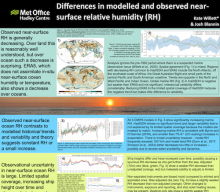Exploring the differences in modelled and observed near-surface humidity
Kate
Willett
Met Office, UK
Poster
Observations (HadISDH in situ product and ERA5 reanalysis) show a decrease in global mean near-surface relative humidity (RH) over land. This is now a reasonably well understood feature of climate change and can be broadly explained by the faster warming rate over land compared to over oceans and the fact that much of the land is water-limited to some extent. Other drivers have been found to contribute, such as reduced evapotranspiration from increased stomatal conductance efficiency in elevated CO2 levels, and changes in atmospheric circulation and land use. The latest models show a long-term decrease in RH but this is smaller than observed. Also, the distinct temporal behaviour in observed global near-surface RH over land, where it remains near-constant until ~2000 and then steeply declines, is not at all replicated in models.
Interestingly, both HadISDH and ERA5 also show decreasing RH over the near-surface oceans since the 1980s, albeit with differing temporal variability. This is incongruous with the theoretical expectation that where water is not limited RH should stay constant as the air and water warm. GCM future projections show constant near-surface RH over the oceans or even small increases. Uncertainty in the observed marine RH is very large but the fact that ERA5, which does not assimilate near-surface in situ observations of temperature and humidity over the oceans, also shows a decrease in RH, presents a puzzle.
This talk summarises what we know so far about the observed trends and variability following recent work exploring possible sources of error in the observations and potential plausible physical drivers of land and marine near-surface RH.
Interestingly, both HadISDH and ERA5 also show decreasing RH over the near-surface oceans since the 1980s, albeit with differing temporal variability. This is incongruous with the theoretical expectation that where water is not limited RH should stay constant as the air and water warm. GCM future projections show constant near-surface RH over the oceans or even small increases. Uncertainty in the observed marine RH is very large but the fact that ERA5, which does not assimilate near-surface in situ observations of temperature and humidity over the oceans, also shows a decrease in RH, presents a puzzle.
This talk summarises what we know so far about the observed trends and variability following recent work exploring possible sources of error in the observations and potential plausible physical drivers of land and marine near-surface RH.

Poster file
willett-kate-confronting.pdf
(1.03 MB)
